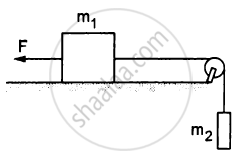Advertisements
Advertisements
प्रश्न
A metre scale is moving with uniform velocity. This implies ______.
विकल्प
the force acting on the scale is zero, but a torque about the centre of mass can act on the scale.
the force acting on the scale is zero and the torque acting about centre of mass of the scale is also zero.
the total force acting on it need not be zero but the torque on it is zero.
neither the force nor the torque need to be zero.
उत्तर
A metre scale is moving with uniform velocity. This implies the force acting on the scale is zero and the torque acting about centre of mass of the scale is also zero.
Explanation:
Since the body is moving with a uniform velocity, hence its acceleration is zero. This implies that the net force acting on it must be zero, which further makes the torque acting about the centre of mass of the scale also zero.
APPEARS IN
संबंधित प्रश्न
A car accelerates on a horizontal road due to the force exerted by.
A smooth wedge A is fitted in a chamber hanging from a fixed ceiling near the earth's surface. A block B placed at the top of the wedge takes time T to slide down the length of the wedge. If the block is placed at the top of the wedge and the cable supporting the chamber is broken at the same instant, the block will.
In a TV picture tube, electrons are ejected from the cathode with negligible speed and they attain a velocity of 5 × 106 m/s in travelling one centimetre. Assuming straight-line motion, find the constant force exerted on the electrons. The mass of an electron is 9.1 × 10−31 kg.
A particle of mass 0.3 kg is subjected to a force F = −kx with k = 15 N/m. What will be its initial acceleration if it is released from a point x = 20 cm?
A constant force F = m2g/2 is applied on the block of mass m1 as shown in the following figure. The string and the pulley are light and the surface of the table is smooth. Find the acceleration of m1.

A body of mass m moving with a velocity v is acted upon by a force. Write an expression for change in momentum in each of the following cases: (i) When v << c, (ii) When v → c and (iii) When v << c but m does not remain constant. Here, c is the speed of light.
A force acts for 10 s on a stationary body of mass 100 kg, after which the force ceases to act. The body moves through a distance of 100 m in the next 5 s. Calculate: The velocity acquired by the body.
A motorcycle of mass 100 kg is running at 10 ms−1. If its engine develops an extra linear momentum of 2000 Ns, calculate the new velocity of a motorcycle.
State Newton's second law of motion. Is Newton's first law of motion contained in Newton's second law of motion?
A ball is thrown vertically downward with an initial velocity of 10 m/s. What is its speed 1 s later and 2 s later?
